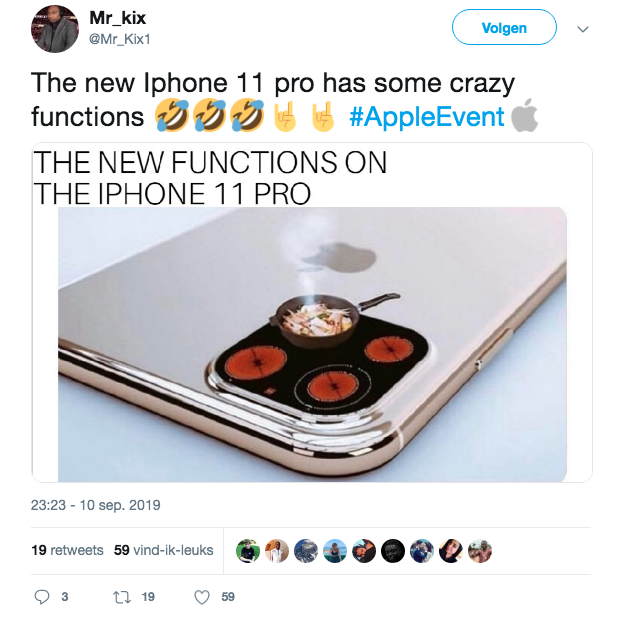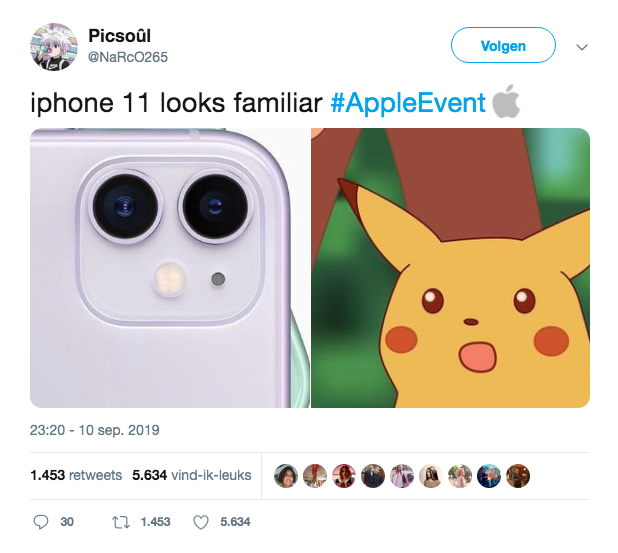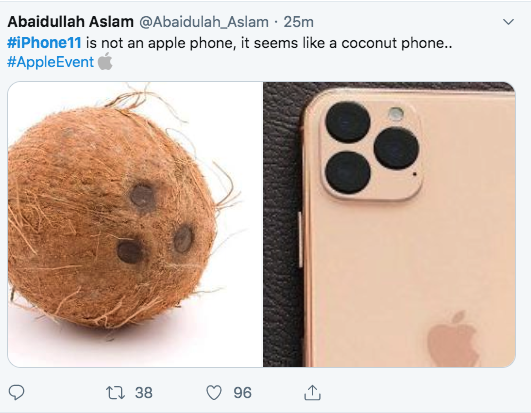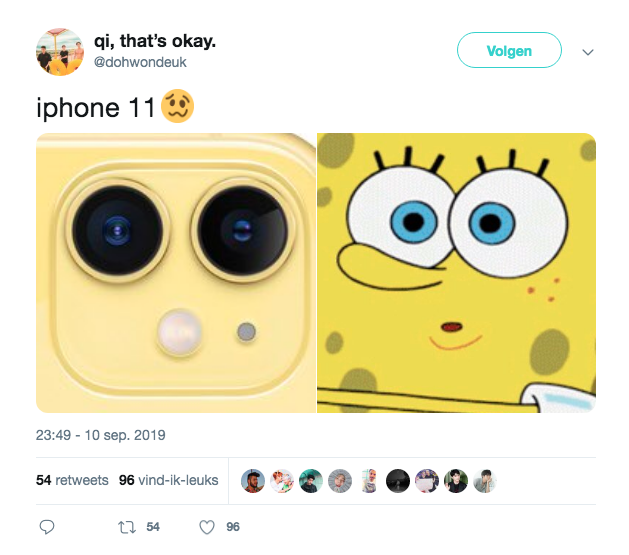iPhone 11 Memes – Online Discourse in Digital Cultures
Apple has recently revealed its latest iPhone at their keynote event in the Steve Jobs Theater in California. The new iPhone 11 offers some new and interesting features, and marks a bold new look for its already iconic design. Besides the fact that it comes in six trendy colors, the most prominent aspect of its new design must be the triple-camera system. The newest Apple smartphone not only claims to have a longer battery life and consumes less power, but it also has multiple cameras, giving users a double optical zoom-out and an ultrawide rear camera (Evans, 2019). Apple describes its latest iPhone 11 as:
“A powerful dual-camera system that captures more of what you see and love. An all-day battery that lets you do more and charge less. And the toughest glass ever in a smartphone.”
Even though the new device has just released, it immediately caused for some interesting reactions on the internet. These bizarre reactions have mainly been caused by the distinctive design of the new smartphone, since the camera now appears to have three lenses as opposed to one. The iPhone’s new look has been the source of inspiration for plenty of memes, comparing the new camera feature to a range of different objects and characters. To name a few examples, the public has made comparisons of the three-lens feature with a cooking stove, a coconut, Pikachu and Spongebob.




The memes making fun of the interesting-looking camera feature have been spread on different social media platforms such as Twitter, Facebook and Instagram. After the first few initial memes, more and more social media users seemed to have been inspired to create their own memes. The internet jokes were spread like a wildfire, resulting in thousands of people liking, sharing and talking about the new iPhone 11 peculiar triple-camera design. As explained by Chesterman (2016) ‘we can see how a given meme starts to spread slowly, reaches a peak of reference frequency, and perhaps thereafter fades again’. This idea can also be applied to the case surrounding the new release of the iPhone 11. Here it started with a few jokes that were posted on the internet wherein the new design of the smartphone was compared to different object. As a result of the sharing and liking of digital users, they gained even more popularity whereby others came up with even more jokes. However, the trend might fade sooner or later.
The internet memes as a reaction to the launch of the new iPhone 11 is just one of the many examples of the role that memes play in our daily lives online. Living in a digital era, memes have become a daily part of our digital lives whether they be ‘political’, ‘branded’, or just a bit of fun. We encounter memes regularly via social media, and sometimes even circulate them ourselves. Memes have become increasingly common in online discourse. They appear on our social media’s news feeds every single day, and are a way to connect with others and have a laugh about certain subject – may they be serious topics of discussion or solely for the purpose of entertainment. Even though memes as we know them are a relatively new area of study, the term meme surprisingly originated more than 40 years ago.
Defining ‘memes’
The concept of memes comes from socio-biology, and was first introduced in Dawkin’s book The Selfish Gene (1976). Dawkin’s aim was to create a term in order to describe the evolution of cultural phenomena. In this sense, a meme can be understood as a unit of cultural transmission or a unit of imitation (Chesterman, 2016). According to Dawkin ‘they propagate themselves by leaping from brain to brain via a process which, in the broad sense, can be called imitation’. This way, we can see memes as replicators. Memes are units of cultural information – cultural practices or ideas – that are transmitted verbally or by repeated action from one mind to another (Hinchman & Chandler-Olcott, 2018). Or said differently, they are artefacts remixed by countless participants, employing popular culture for public commentary. Memes can be rapidly diffused by members of participatory digital culture for the purpose of satire, parody, critique or other discursive activity. Its function is to posit an argument in a visual way, with the aim to commence, extend, counter of influence a discourse. They can be seen as ‘half-baked jokes’ that require us to ‘finish the sentence’. In order to understand these unfinished jokes, we need some context – we need to understand ‘the references to the cultural and social issues, popular and alternative culture, general knowledge and media awareness, internet and political literacy, and the ability to connect the disconnected’, (Denisova & Wiggins, 2019).
Despite the fact that the term is older than you might expect it to be, the reality of memes has changed throughout the years. Memes have quickly and purposefully been altered and transformed due to human agency. This change of memes is something that cannot be avoided, since they are more than imitations – they are remixes and iterations. As expressed by Denisova and Wiggins (2019) ‘internet memes are intrinsically linked to the logic and rhythms of networks and social media, as well as to the ways a society expresses and thinks of itself.’
This blogpost has demonstrated some ways in which memes have become an important part in the daily lives of users of digital media, exemplified by the reaction of internet users to Apple’s new release. This has shown that with the popularity of social media, just about anyone can offer his or her opinion on any subject – seemingly without consequences. Everyone with connection to the internet can nowadays express his or her ideas. Even though it seems innocent to joke about different topics of interest, it could lead to fake news, misconceptions or even hate (Castanedra Jr, 2017). That is one of the reasons why it is of importance to take memes a bit more seriously than they may are intended to be, with an eye on the relevant role they play within the field of new media and digital cultures today. Despite being a term that originated years ago, it is a highly relevant topic of study as it seems to be part of our daily lives and they ways we connect with others online.
References
Castaneda Jr, J. (2017). Memes of misinformation: Unravelling the controversial, socio-economic and political issues behind those annoying social media memes (Vernan series in communication). Wilmington: Vernon Press.
Chesterman, A. (2016). Memes of translation: The spread of ideas in translation theory. (Revised ed., Est Subseries, volume 123) [Revised edition.]. Amsterdam: John Benjamins Publishing Company.
Denisova, A., & Wiggins, B. (2019). The Importance of Memes. European Journal of Communication, 34(5), 552-563. doi: 10.1177/0267323119873742.
Evans, G. (2019, September 11). Apple’s newest iPhone design has inspired a lot of jokes. Retrieved from https://www.indy100.com
Hinchman, K., & Chandler-Olcott, U. (2018). Memes. Journal of Adolescent & Adult Literacy, 62(3), 249-251. doi: 10.1002.jaal.918.